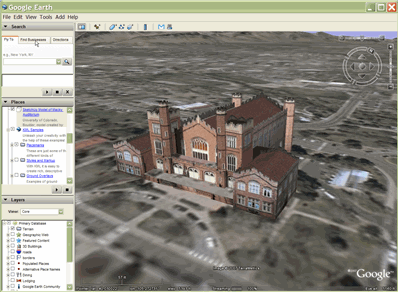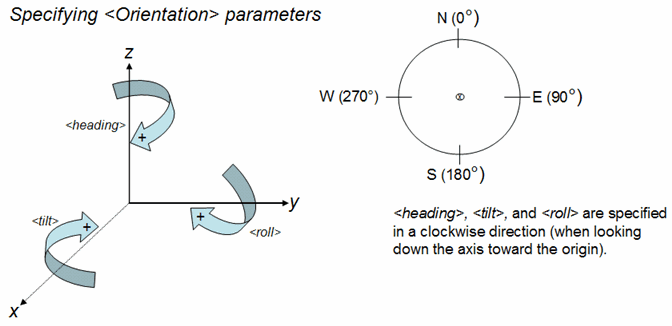 |
您可在 KML 中以 COLLADA 交互式檔案格式匯入 3D 模型,例如建築物、橋樑、紀念碑和雕像,模型本身是以獨立座標空間的方式獨立於 Google 地球中,並使用 GMS、3D Studio Max、Softimage XSI 或 Maya 等應用程式。將 3D 模型匯入 Google 地球後,就會進行平移、旋轉和縮放,以符合「Google 地球」座標系統。已載入至「Google 地球」的模型可以使用 <Update> 元素來重新定位及調整大小。 |
範例模型
「Google 地球」中的模型可像任何其他幾何圖形物件 (點、線條或多邊形) 一樣使用。以下是匯入紋理紋理的 KML 檔案範例。
模型的 <Link> 參照可以是絕對或相對檔案規格,也可以是網址。
如要查看這個模型,請載入 MackyBldg.kmz 檔案,此檔案包含所有必要的紋理與疊加層檔案,以及包含此模型的 doc.gp 檔案:
<?xml version="1.0" encoding="UTF-8"?>
<kml xmlns="http://www.opengis.net/kml/2.2">
<Placemark>
<name>SketchUp Model of Macky Auditorium</name> <description>University of Colorado, Boulder; model created by Noël Nemcik.</description>
<LookAt>
<longitude>-105.2727379358738</longitude>
<latitude>40.01000594412381</latitude> <altitude>0</altitude> <range>127.2393107680517</range>
<tilt>65.74454495876547</tilt> <heading>-27.70337734057933</heading> </LookAt> <Model id="model_4"> <altitudeMode>relativeToGround</altitudeMode>
<Location>
<longitude>-105.272774533734</longitude>
<latitude>40.009993372683</latitude>
<altitude>0</altitude>
</Location>
<Orientation>
<heading>0</heading>
<tilt>0</tilt>
<roll>0</roll>
</Orientation>
<Scale>
<x>1</x>
<y>1</y>
<z>1</z>
</Scale> <Link> <href>MackyBldg.kmz/files/CU Macky.dae</href> </Link>
<ResourceMap id="resourcemap_for_model_4"> <Alias>
<sourceHref>../files/CU-Macky---Center-StairsnoCulling.jpg</sourceHref>
<targetHref>C:/DOCUME~1/josiew/LOCALS~1/Temp/MackyBldg.kmz/files/CU-Macky---Center-StairsnoCulling.jpg</targetHref>
</Alias>
<Alias>
<sourceHref>../files/CU-Macky-4sideturretnoCulling.jpg</sourceHref>
<targetHref>../files/CU-Macky-4sideturretnoCulling.jpg</targetHref>
</Alias>
<Alias>
<sourceHref>../files/CU-Macky-Back-NorthnoCulling.jpg</sourceHref>
<targetHref>../files/CU-Macky-Back-NorthnoCulling.jpg</targetHref>
</Alias>
<Alias>
<sourceHref>../files/CU-Macky-BrickwallnoCulling.jpg</sourceHref>
<targetHref>../files/CU-Macky-BrickwallnoCulling.jpg</targetHref>
</Alias> . . . </ResourceMap>
</Model>
</Placemark>
</kml>
模型是根據地理位置元素的緯度、經度和海拔規格來定位。這個範例使用 [方向] 和 [比例] 元素的預設值,為附上完整資訊,這些元素提供了完整資訊。
方向元素可指定模型在 x (傾斜)、y (roll) 和 z (heading) 軸周圍的旋轉角度。y 軸指向北方且與經度線平行,x 軸則指向東方,與緯度線平行。旋轉以度數指定,正向旋轉,如下圖所示。

ResourceMap 元素會將紋理檔案從原始 Collada 檔案中指定的位置 (<sourceHref>) 對應至包含模型的 KML 或 KMZ 檔案 (<targetHref>) 中的位置。
注意:在 Google 地球 4.2 之前的版本中,這個對應函式是由 textures.txt 檔案 (KMZ 封存檔案中包含的外部檔案) 執行。Google 地球 4.2 版可接受 KML 和 KMZ 檔案,參照 textures.txt 檔案並正確處理。當 Google 地球 4.2 用戶端與後續版本編寫這類檔案時,textures.txt 檔案中的資訊會轉譯為 <ResourceMap> 及 <Alias> 元素 (也就是 <Model> 的子項)。
建立 .kmz 封存檔案
KMZ 封存是檔案,可用來建立單一 KML 簡報。此封存檔包含 .KML 檔案參照的所有本機檔案,例如圖片、紋理和模型。KMZ 封存檔案是獨立套件,不需要透過網路伺服器代管,而且可以輕鬆透過電子郵件傳送,並以單一單元的形式儲存。Google 地球可以直接讀取 .KML 和 .kmz 檔案。
使用 ZIP 檔案格式,將 doc.KML 檔案及其參照的本機檔案壓縮為封存檔。許多應用程式都可以產生這種格式。Windows 系統中的 WinZip 和 Macintosh 系統上的 Stuffit,以及 Linux 或 Macintosh 系統上的 zip 都是可讀取及寫入 ZIP 格式的常見應用程式。您也可以直接使用 Windows 檔案總管或 Mac Finder 使用 ZIP 封存檔。
建立 .zip 檔案後,請將副檔名變更為 .kmz。
包含 Macky Building 完整紋理模型的 KMZ 封存檔包含下列檔案:
- doc.zoom - 如上所示的 KML 檔案,它會匯入 COLLADA (.dae) 模型並將其放到「Google 地球」中。將這個檔案放在 KMZ (ZIP) 檔案的根目錄中。
- files/ directory - 包含用於定義模型幾何圖形、紋理和材質的 COLLADA 檔案。在 Macky Building 範例中,這個目錄包含 COLLADA 檔案 (CU Macky.dae),以及用來製作建築物紋理的 JPEG 圖片許多檔案 (CU-Macky-BrickwallnoCulling.jpg、CU-Macky.Center-br
這個範例說明如何在 KMZ 封存中建構檔案結構。實際上,您可以將檔案整理成任何對您有邏輯的結構,就像整理電腦中的資料夾或目錄一樣。舉例來說,建議您將所有圖片都放入 images/ 目錄。相對參照 (例如 NetworkLink、Link、Overlay/II 和 Model 中 <href> 元素所參照的檔案) 相對於 doc.KML 檔案。如果加入圖片目錄,則圖片的 <href> 規格為:images/myBrickTexture.jpg、images/myMountainOverlay.png 等)。
